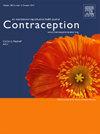寻求人工流产护理的性少数群体和异性恋患者所经历的挑战类型的差异
IF 2.8
2区 医学
Q1 OBSTETRICS & GYNECOLOGY
引用次数: 0
摘要
目标虽然性少数群体与异性恋女性一样或更有可能需要堕胎,但很少有研究探讨她们寻求堕胎护理的经历。本研究探讨了寻求人工流产的性少数群体和异性恋患者所面临挑战的差异。方法我们分析了 2020 年 4 月至 2022 年 4 月期间在美国中西部 25 家诊所寻求人工流产的 1833 人的调查数据。我们研究了与寻求人工流产相关的总体挑战类型和数量,以及不同性别身份(性少数群体与异性恋)的挑战类型和数量。我们进行了负二项回归,以量化不同性别身份的挑战数量差异,并控制了通常与寻求堕胎挑战相关的因素。大多数参与者,无论其性身份如何,都至少面临过一次挑战(90%),性少数群体参与者平均经历了 3.8 次挑战,而异性恋参与者为 3.0 次(p<0.001)。与异性恋参与者相比,性取向少数群体更有可能面临几乎所有的挑战,包括费用(73% 对 64%;p<0.01)、交通(19% 对 12%;p<0.001)、情感负担(40% 对 29%;p<0.001)以及保守怀孕/堕胎秘密(40% 对 31%;p<0.01)。在控制其他因素的情况下,性取向少数群体面临的挑战明显多于异性恋参与者(aIRR=1.20;p<0.001)。解决社会中以及生殖保健中的不平等问题将有助于确保所有人都能获得堕胎服务,包括那些被认定为性少数群体的人。本文章由计算机程序翻译,如有差异,请以英文原文为准。
DIFFERENCES IN TYPES OF CHALLENGES EXPERIENCED BY SEXUAL MINORITY AND HETEROSEXUAL PATIENTS SEEKING ABORTION CARE
Objectives
Although sexual minorities are equally or more likely to need an abortion as heterosexual women, little research examines their experiences seeking abortion care. This study examines differences in challenges faced by sexual minority and heterosexual patients seeking abortion.
Methods
We analyzed survey data from 1,833 individuals who sought an abortion at 25 clinics in the Midwest from April 2020 to April 2022. We examined the types and number of challenges related to seeking abortion overall, and by sexual identity (sexual minority vs. heterosexual). We conducted negative binomial regression to quantify differences in number of challenges by sexual identity, controlling for factors commonly associated with challenges seeking abortion.
Results
A fifth of participants identified as a sexual minority (19%). Most participants, regardless of sexual identity, faced at least one challenge (90%), with sexual minority participants experiencing a mean of 3.8 challenges compared to 3.0 for heterosexual participants (p<0.001). Sexual minorities were more likely than heterosexual participants to face nearly every challenge presented, including cost (73% vs. 64%; p<0.01), transportation (19% vs. 12%; p<0.001), emotional burden (40% vs. 29%; p<0.001), and keeping the pregnancy/abortion secret (40% vs. 31%; p<0.01). Controlling for other factors, sexual minorities faced significantly more challenges than heterosexual participants (aIRR=1.20; p<0.001).
Conclusions
Sexual minorities may need additional and tailored support when seeking an abortion, including financial, logistical, and emotional support specific to their circumstances. Addressing inequalities within society, as well as within reproductive healthcare, will help ensure that abortion is accessible to all, including those who identify as sexual minorities.
求助全文
通过发布文献求助,成功后即可免费获取论文全文。
去求助
来源期刊

Contraception
医学-妇产科学
CiteScore
4.70
自引率
17.20%
发文量
211
审稿时长
69 days
期刊介绍:
Contraception has an open access mirror journal Contraception: X, sharing the same aims and scope, editorial team, submission system and rigorous peer review.
The journal Contraception wishes to advance reproductive health through the rapid publication of the best and most interesting new scholarship regarding contraception and related fields such as abortion. The journal welcomes manuscripts from investigators working in the laboratory, clinical and social sciences, as well as public health and health professions education.
 求助内容:
求助内容: 应助结果提醒方式:
应助结果提醒方式:


